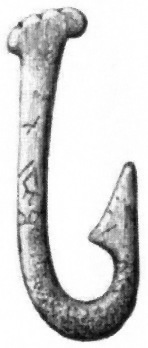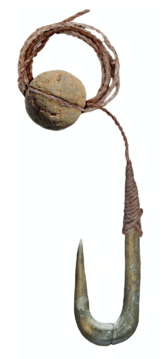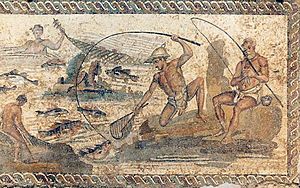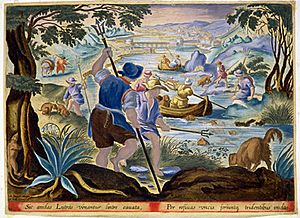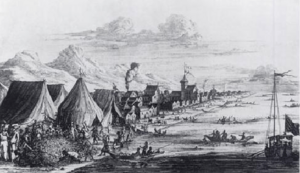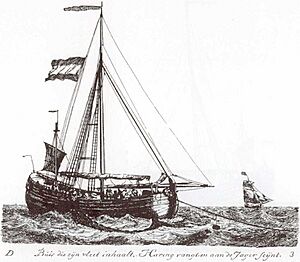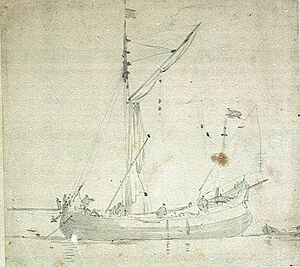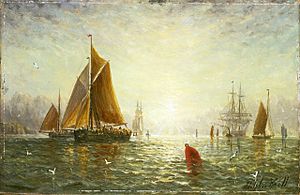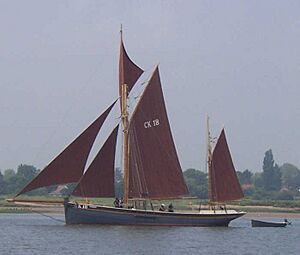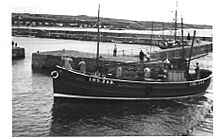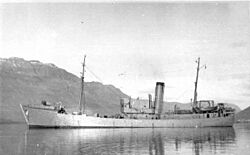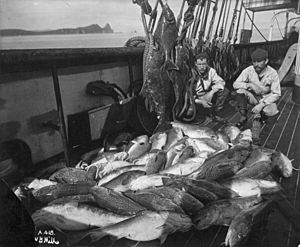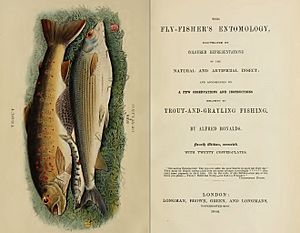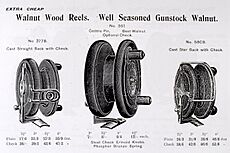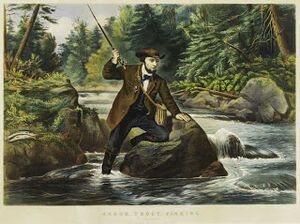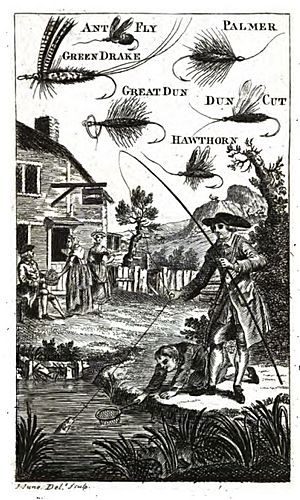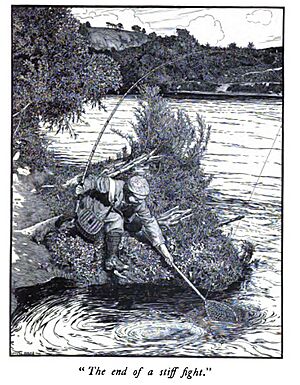History of fishing facts for kids
Fishing is a very old activity that people have been doing for at least 70,000 years! For a long time, people mostly caught fish in the wild. They used different ways to catch them, like gathering them by hand, spearing them, using nets, fishing with a rod and line, or setting traps.
When we talk about fishing, we usually mean catching fish. But it can also mean catching other sea creatures like crabs, lobsters, squid, and starfish. However, it usually doesn't include catching sea mammals like whales, which is called whaling. It also doesn't include fish raised on farms. Besides providing food, fishing is also a popular sport today!
Around the world, about 38 million people work as fishermen or fish farmers. Fishing and fish farming provide jobs for over 500 million people! In 2005, people around the world ate about 14.4 kilograms of wild-caught fish per person, plus another 7.4 kilograms from fish farms.
Contents
Ancient Fishing Methods
-
A Stone Age fish hook made from bone.
Fishing is an ancient practice that started at least 40,000 years ago. Scientists found that a 40,000-year-old human from Asia, called Tianyuan man, ate a lot of freshwater fish. Old piles of shells, discarded fish bones, and cave paintings show that seafood was very important for survival. In those days, most people moved around a lot to find food. But in places where people settled down, even for a short time, like at Lepenski Vir, fishing was almost always a main source of food.
People used barbed poles, like harpoons, to spear fish a long time ago. In a cave in Southern France, called Cosquer cave, there are drawings over 16,000 years old that show seals being harpooned.
Between 4,000 and 8,000 years ago, new ways of farming and making pottery spread around the world. With these new technologies came basic forms of the main fishing methods we still use today.
Native Americans on the California coast fished with hooks and lines from 7500 to 3000 years ago. Some tribes even used plant poisons to make stream fish sleepy so they could catch them easily.
In ancient India, people called the Mincopie used harpoons with long cords for fishing a very long time ago.
Early History of Fishing
The ancient Nile River in Egypt was full of fish. Fresh and dried fish were a main food for many people. The Egyptians invented many tools and ways to fish. These are clearly shown in tomb paintings and old papers. Simple boats made of reeds were used for fishing. People used woven nets, traps made from willow branches, harpoons, and hooks with lines. By the 12th dynasty, metal hooks with barbs were being used. Just like today, fish were often hit with a club to kill them after being caught. Nile perch, catfish, and eels were some of the most important fish. Some pictures even suggest that fishing was a fun hobby.
Old books often mention fishing, but they don't always describe the tools in detail. For example, the Bible mentions "fish spears."
In ancient Greece, fishing scenes are not often shown in art, which might mean fishing was not seen as a high-status job. But there is an old wine cup from around 500 BC that shows a boy fishing with a rod and a basket. In the water, there's a rounded object that might have been a cage to keep live fish or a trap.
A Greek writer named Oppian wrote a big book about sea fishing called Halieutika between 177 and 180 AD. This is the oldest complete book about fishing that we still have today. Oppian described different ways of fishing, like using nets from boats, scoop nets, spears, and traps that "work while their masters sleep." He also described fishing with a "motionless" net:
- Fishermen would set up light nets and then hit the water with their oars to make a lot of noise. The fish would get scared by the noise and rush into the net, thinking it was a safe place. Then the fishermen would quickly pull the net ashore.
The Greek historian Polybius (around 203–120 BC) described hunting swordfish with a harpoon that had a barbed, detachable head.
Roman art, like mosaics, shows people fishing from boats with rods and lines, as well as nets. They caught many different sea creatures like eels, lobsters, sea urchins, octopuses, and cuttlefish. In a type of Roman gladiator fight, a gladiator called a retiarius fought with a trident (a three-pronged spear) and a net, against another gladiator who had a short sword and a helmet shaped like a fish.
The Roman sea god Neptune is often shown holding a fishing trident.
In India, a kingdom called the Pandyas was famous for pearl fishing as early as the 1st century BC. Their port city, Tuticorin, was known for deep-sea pearl diving. The local people, called paravas, became a rich community because of their pearl trade and fishing skills.
In Norse mythology, the sea giantess Rán uses a fishing net to catch lost sailors.
The Moche people of ancient Peru showed fishermen in their pottery.
From old pictures and writings, we know that early fishing boats were usually small. They didn't have masts or sails and were only used close to the shore.
In traditional Chinese history, a legendary figure named Fuxi is said to have invented writing, hunting, trapping, and fishing around 2800–2600 BC.
Gillnets Through History
Gillnets, which are nets that catch fish by their gills, have been around since ancient times. In North America, Native American fishermen used canoes and nets made from plant fibers. They would attach stones to the bottom for weights and wood pieces to the top for floats, making the net hang straight in the water. These nets were either tied to the shore or held between two boats. Native fishermen in places like Canada and Alaska still use gillnets for salmon and trout.
Gillnets have been used by cultures all over the world. Japanese records show that gillnetting has been used for over 3,000 years. In Norway, fishermen used gillnets for herring. Many Norwegian fishermen who came to America in the 1800s to fish for salmon already knew how to use gillnets from fishing for cod back home.
Today, gillnets are not used as much in modern commercial fishing because of new rules. This is because gillnets can catch and harm other unintended sea creatures, which is called bycatch.
The Cod Trade
One of the longest-lasting trades in the world is the trade of dried cod from Norway to southern Europe (Italy, Spain, and Portugal). This trade started during the Viking period, or even earlier, and has been going on for more than 1000 years! It's still important today.
Cod has been a valuable product in the international market since the Viking period (around 800 AD). Norwegians used dried cod during their travels, and soon a market for it grew in southern Europe. This market has survived many challenges like the Black Death and wars. The Portuguese have been fishing for cod in the North Atlantic since the 1400s, and dried salted cod is very popular in Portugal. The Basques also played a big part in the cod trade and are thought to have found the rich fishing areas off Canada in the 1500s. Many cities on the east coast of North America grew because of the huge amounts of cod there.
What's special about this trade is that the fishing grounds were far from big cities and there wasn't much local demand for the fish. The large cod fisheries off North Norway were mainly for export, meaning the fish had to be shipped long distances. By the late 1300s, a group of trading cities called the Hanseatic League took over the trade, with Bergen in Norway being the main port.
A British leader, William Pitt, once said that cod was "British gold" and that it was foolish to give fishing rights in Newfoundland back to the French after a war in 1763. In the 1600s and 1700s, cod became a very important product in the New World, especially in Massachusetts and Newfoundland, creating big trade networks.
Modern Fishing Boats
Early Designs
In the 1400s, the Dutch developed a type of sea-going herring boat called the Herring Buss. This boat became a model for other European fishing boats. The Herring Buss was used by Dutch herring fishermen until the early 1800s. This type of ship has a long history, going back to Viking times around 1000 AD. The first Herring Buss was likely built around 1415.
These ships were about 20 meters long and weighed between 60 and 100 tons. They were strong, round-bottomed boats with a rounded front and back. The busses used long nets that drifted in the water to catch herring. The nets were pulled in at night, and the crew of 18 to 30 men would clean, salt, and barrel the fish right on the deck. These ships sailed in large groups of 400 to 500 boats to fishing areas like the Dogger Bank. They were often protected by navy ships because the English thought they were "poaching." The fleet would stay at sea for weeks. Sometimes, the catch would be moved to special ships that would take it back to shore while the fishing fleet stayed out.
During the 1600s, the British developed the dogger, an early type of sailing trawler or longliner, often used in the North Sea. The name "dogger" comes from a Dutch word for a fishing boat that pulls a net. Dutch trawling boats were common in the North Sea, and the area where they fished became known as the Dogger Bank.
Doggers were slow but strong boats, able to fish in the rough North Sea. They were wide and rounded like the herring buss but smaller, about 15 meters long. They could carry a lot of bait, salt, food, and firewood, and return with six tons of fish. They likely had areas for the crew to sleep and cook. An anchor allowed them to stay in one spot for a long time. The dogger also carried a small open boat for working with lines and going ashore.
A boat similar to the dory was used in France as early as 1671. Dories themselves appeared in New England fishing towns after the early 1700s. They were small, shallow boats, usually about five to seven meters long. They were light, easy to build, and cheap, with high sides, a flat bottom, and sharp fronts. The Banks dories appeared in the 1830s. They were designed to be carried on larger "mother ships" and used for catching cod at the Grand Banks. These dories could be stacked inside each other on the decks of fishing schooners for the trip to the fishing grounds.
Modern Fishing Trawlers
While the British dogger was an early type of trawler from the 1600s, the modern fishing trawler was developed in the 1800s in the English fishing port of Brixham.
By the early 1800s, fishermen in Brixham needed to fish further out because there were fewer fish in the waters near shore. The Brixham trawler that they developed was sleek and had a tall sail, which made it fast enough to travel long distances to fishing grounds in the ocean. They were also strong enough to pull large nets in deep water. The big fleet of trawlers that grew in Brixham earned the village the name 'Mother of Deep-Sea Fisheries'.
This new boat design made large-scale trawling in the ocean possible for the first time. This led to many fishermen moving from southern England to northern towns like Scarborough, Hull, Grimsby, and Yarmouth, which were closer to the big fishing areas in the Atlantic Ocean.
The small village of Grimsby grew to become the 'largest fishing port in the world' by the mid-1800s. In 1796, a law was passed to build new docks and make the harbor deeper. But it was in 1846, with the huge growth in fishing, that the Grimsby Dock Company was formed. Prince Albert laid the first stone for the Royal Dock in 1849. Queen Victoria officially opened the dock in 1854 as the first modern fishing port. The dock used new ideas of the time: its gates and cranes worked with power from water pressure, and the tall Grimsby Dock Tower was built by William Armstrong to provide enough water pressure. The docks kept growing, and by 1934, there were three fish docks. A railway link to London's Billingsgate Fish Market meant that Grimsby's fish could be sold all over the country, making it famous.
The elegant Brixham trawler design spread worldwide, influencing fishing fleets everywhere. Their unique sails even inspired the song "Red Sails in the Sunset." By the end of the 1800s, Britain had over 3,000 fishing trawlers, with almost 1,000 in Grimsby alone. These trawlers were sold to fishermen across Europe, including Holland and Scandinavia. Twelve trawlers even became the start of the German fishing fleet.
While fishing boat designs became more similar globally, local conditions still led to different types of boats. The Lancashire nobby was used for shrimp fishing in northwest England from 1840 until World War II. The Manx nobby was used around the Isle of Man for herring. The fifie was also used for herring along the east coast of Scotland from the 1850s.
The Arrival of Steam Power
The first fishing boats powered by steam appeared in the 1870s. They used nets, lines, and drift nets. These were large boats, usually 24-27 meters long and about 6 meters wide. They weighed 40-50 tons and traveled at 9-11 knots (about 10-12 miles per hour).
The very first boats built specifically for steam fishing were designed by David Allan in Scotland in 1875. In 1877, he built the world's first steam trawler with a screw propeller, named Pioneer. She was made of wood and had two masts. Allan said his goal was to make fishing safer for fishermen. However, local fishermen saw these powerful trawlers as a threat. Allan built ten boats between 1877 and 1881, and another 21 until 1886. Most of these were sold to other countries like France, Belgium, and Spain.
The first steam boats were made of wood, but soon steel hulls were used. These boats were divided into watertight sections. They were well designed for the crew, with a large area that held the wheelhouse and deckhouse. Boats built in the 1900s only had a small sail at the back, which helped steady the boat when its nets were out. The main mast was now used as a crane to lift the catch ashore. They also had a steam-powered winch at the front for pulling in nets. The boats had tall, narrow funnels so that the steam and coal smoke went high above the deck, away from the fishermen. These funnels were nicknamed 'woodbines' because they looked like a popular brand of cigarette. These boats had a crew of twelve: a skipper, a driver, a fireman (to look after the boiler), and nine deck hands.
Steam fishing boats had many benefits. They were usually about 6 meters longer than sailing boats, so they could carry more nets and catch more fish. This was important because the demand for fish was growing fast in the early 1900s. They could travel faster and further, and were less affected by weather, wind, and tides. Because they spent less time traveling, they could spend more time fishing. Steam boats also got the best prices for their fish because they could return to harbor quickly with fresh catches. However, the main problem with steam boats was their high running costs. Their engines were not very efficient and took up a lot of space, and fuel and setup costs were very high. Before World War I, building a steam boat cost between £3,000 and £4,000, which was at least three times more than a sailing boat. To cover these costs, they needed to fish for longer seasons. The higher costs meant that more steam boats were owned by companies or jointly by several people. As the herring fishing industry declined, steam boats became too expensive.
Steam trawlers were first used in Grimsby and Hull in the 1880s. In 1890, it was estimated that 20,000 men worked in the North Sea. The steam drifter was not used for herring fishing until 1897. The last sailing fishing trawler was built in Grimsby in 1925.
Further Developments
Trawler designs changed as their power source evolved from sails to coal-fired steam by World War I, and then to diesel engines and turbines by the end of World War II.
During both World Wars, many fishing trawlers were used as naval ships. Fishing trawlers were perfect for many navy needs because they were strong boats designed to pull heavy nets in all kinds of weather and had large, clear decks. A trawler could become a minesweeper by simply replacing the net with a mine sweep. Adding depth charge racks, sonar (a device that uses sound to detect objects underwater), and a gun made the trawler ready for fighting submarines.
The British Navy ordered many naval trawlers built to their own designs. Shipyards that usually built fishing trawlers could easily switch to making naval versions. As a bonus, the Navy could sell these trawlers to commercial fishermen after the wars ended. Still, many were sunk during the war.
Armed trawlers were also used to protect fishing groups from enemy planes or submarines. The smallest civilian trawlers were turned into boats that laid buoys.
In 1931, the first powered drum was invented by Laurie Jarelainen. This drum was a round device on the side of the boat that would pull in the nets. The powered drum made it much faster to pull in nets, allowing fishermen to go to areas they couldn't reach before. This changed the fishing industry.
During World War II, navigation and communication devices, as well as other sea equipment like depth-sounders and radar, got much better and smaller. These devices became easier for regular fishermen to get, which increased their range and ability to move around. It also made the industry more competitive, as fishermen had to invest more in their boats, equipping them with electronic aids like radio navigation and fish finders. During the Cold War, some countries even put extra electronic gear on fishing trawlers to use them as spy ships to watch other countries.
The first trawlers pulled their nets over the side of the boat, not the back. In 1947, a company in Scotland changed a leftover minesweeper into the first combined freezer/stern trawler. This boat had refrigeration and a ramp at the back to pull nets in.
The first boat built specifically as a stern trawler was the Fairtry in 1953. This ship was much bigger than any other trawlers at the time and started the era of the 'super trawler'. Since the ship pulled its nets over the back, it could lift much larger catches, up to 60 tons. The Lord Nelson followed in 1961, with special freezers that had been developed by a research station. These ships helped the 'super trawler' idea spread around the world in the following decades.
In the 1960s, the use of fine man-made fibers like nylon for fishing gear led to a big increase in the use of gillnets for commercial fishing. The new materials were cheaper, easier to handle, lasted longer, and needed less care than natural fibers. Also, nylon lines are almost invisible in water, so nets made with them generally caught more fish. However, due to environmental concerns, the United Nations banned gillnets in international waters in 1993, though they are still allowed within 200 nautical miles of a coast.
Fishing as a Hobby
It's not entirely clear when fishing first became a hobby. For example, there are stories about fly fishing in Japan as early as the 800s BC, and a Roman writer described fly fishing in Europe around 200 AD.
But for these early people, fly fishing was probably a way to get food, not just for fun. It's possible that early forms of recreational fly fishing came to England with the Norman conquest in 1066. While the exact moment fishing became a hobby is unclear, it was definitely a popular pastime when the famous book The Compleat Angler was published.
The Start of Recreational Fishing
The earliest English essay about fishing for fun was published in 1496, soon after the printing press was invented. This essay was thought to be written by Dame Juliana Berners, a nun. It was called Treatyse of Fysshynge wyth an Angle and was part of a larger book about hawking, hunting, and heraldry. These were popular hobbies for rich people, and the publisher wanted to keep the book away from those who were not gentlemen, fearing they might "destroy" the sport by overfishing.
During the 1500s, this book was widely read and reprinted many times. Treatyse gave detailed information on where to fish, how to make rods and lines, and how to use natural baits and fake flies. It also talked about modern ideas like protecting fish and being polite while fishing.
The first English poem about fishing, The Secrets of Angling, was published in 1613 by John Dennys. Notes in the book mention the phrase "to cast a fly" for the first time.

Fly fishing really grew after the English Civil War, with many new books written about it. A famous army officer, Robert Venables, published The Experienced Angler in 1662. Another Civil War veteran, Richard Franck, also loved fishing. He was the first to describe salmon fishing in Scotland and was good at fishing for trout with fake flies.
The Compleat Angler was written by Izaak Walton in 1653 (he kept adding to it for 25 years). It described fishing in the River Wye and celebrated the art and spirit of fishing. Walton wasn't an expert at fly fishing himself; that part of the book was written by Thomas Barker. But Walton was a master at using live worms, grasshoppers, and frogs. The famous line about the frog – "use him as though you loved him, that is, harm him as little as you may possibly, that he may live the longer" – is in the original book. Walton's friend Charles Cotton added more instructions on fly fishing and listed 65 types of fake flies.
Charles Kirby designed a better fishing hook in 1655 that is still very similar today. He also invented the Kirby bend, a special hook with an offset point.
How Fishing as a Hobby Grew
The 1700s were mostly about making the fishing techniques from the previous century even better. Rings started appearing along fishing rods, giving anglers more control over the line. The rods themselves also became more advanced and specialized for different types of fishing. Rods that could be joined together became common, and bamboo was used for the top part of the rod, making it much stronger and more flexible.
The fishing industry also became commercial. Rods and tackle were sold in stores. After the Great Fire of London in 1666, skilled workers moved to Redditch, which became a center for making fishing products from the 1730s. Onesimus Ustonson opened his shop in 1761 and was a market leader for the next century. He even received special permission to supply fishing gear to three kings, starting with King George IV.
Some people say Onesimus invented the multiplying fishing reel, though he was certainly the first to sell it. Early multiplying reels were wide and had small gears made of brass, which often wore out. His first advertisement from 1768 was called To all lovers of angling. It listed all the gear he sold, including fake flies and "the best sort of multiplying brass winches." The growth of the industry happened as more rich people became interested in fishing as a hobby.
The Industrial Revolution first affected how fly lines were made. Instead of anglers having to twist their own lines, which took a lot of work, new textile machines made it easy to produce many different types of lines.
British fly-fishing continued to grow in the 1800s, with new fly fishing clubs and many books about tying flies and fishing techniques.
Alfred Ronalds learned fly fishing on rivers like the Trent and Dove. On the River Blythe, he built a small fishing hut by the river to watch how trout behaved. From this hut, Ronalds did experiments and developed the ideas that he published in his book The Fly-fisher's Entomology in 1836.
He combined his fishing knowledge with his skills as an engraver and printer to fill his book with 20 color pictures. It was the first detailed book about the insects that fly fishermen use, and most fishing historians say Ronalds set a standard in 1836 that is still followed today. Describing methods, techniques, and, most importantly, fake flies, in a clear way for anglers and showing them in color is a style seen in most fly-fishing books today.
The book was mostly about aquatic insects like mayflies, caddisflies, and stoneflies that trout and grayling eat, and the fake flies that copy them. About half the book was about watching trout, their behavior, and how to catch them. Ronalds was the first author to start standardizing the names anglers use for fake flies. Before his book, anglers were given suggestions for flies to use on a certain river or at a certain time of year, but those suggestions were never matched to specific natural insects.
Improvements in Technology
Modern fishing reel designs started in England in the late 1700s. The main type used was called the 'Nottingham reel'. This reel had a wide drum that spun freely, which was great for letting the bait drift far out with the current. Reels that multiplied the line speed didn't become popular in Britain but had more success in the United States. There, similar models were changed by George Snyder of Kentucky into his bait-casting reel, the first American-made design in 1810.
The material used for the fishing rod itself changed from heavy local woods to lighter and more flexible types imported from places like South America. Bamboo rods became the most popular choice from the mid-1800s. Several strips of bamboo were cut, shaped, and then glued together to make light, strong, hexagonal rods that were much better than anything before them.
Fishing gear design started to get better from the 1880s. New woods used for fly rods made it possible to cast flies into the wind using silk lines, instead of horse hair. These lines allowed for much longer casts. However, these early fly lines were tricky because they had to be coated with different things to make them float. They also needed to be taken off the reel and dried every few hours to stop them from getting waterlogged. Another problem was that the much longer line could easily get tangled. This problem led to the invention of a regulator to spool the line evenly and prevent tangles.
An American named Charles F. Orvis designed and sold a new reel and fly design in 1874. It's called the "benchmark of American reel design" and the first truly modern fly reel. The Orvis Company helped make fly fishing more organized by selling fishing equipment through catalogs to a small but dedicated group of customers.
Albert Illingworth, a rich textile maker, patented the modern spinning reel in 1905. With Illingworth's reel, the line came off the front edge of the spool, but a special device picked it up and rewound it as it spun around the stationary spool. Because the line didn't have to pull against a spinning spool, much lighter lures could be cast than with older reels.
The Growth of Fishing as a Hobby
By the mid to late 1800s, more free time for middle and lower classes led to fly fishing becoming much more popular. The growth of the railway system in Britain allowed people with less money to take weekend trips to the coast or rivers for fishing for the first time. Richer hobbyists traveled even further. The large rivers of Norway, full of salmon, started to attract many English fishermen in the mid-1800s. A popular guide to Norway for salmon fishing was published in 1848.
In southern England, dry-fly fishing became known as the only proper way to fish the slower, clearer rivers. The plants in these rivers grow very close to the surface, so new techniques were needed to keep the fly and line on top of the water. These techniques became the basis for all later dry-fly developments.
However, wet flies could also be used successfully on these rivers, as G. E. M. Skues showed with his nymph and wet fly techniques. To the dismay of dry-fly purists, Skues later wrote two books that greatly influenced the development of wet fly fishing. In northern England and Scotland, many anglers also preferred wet-fly fishing, where it was more popular than in southern England. One of Scotland's main supporters of the wet fly in the early to mid-1800s was W. C. Stewart, who published "The Practical Angler" in 1857.
In the United States, ideas about fly fishing methods were not as strict, and both dry- and wet-fly fishing were quickly adapted to the country's conditions. Fly anglers there are thought to be the first to use fake lures for bass fishing. After using flies and gear meant for trout and salmon to catch bass, they started to create specific bass flies. Fly anglers looking for bass developed the spinner/fly lure and bass popper fly, which are still used today.
In the late 1800s, American anglers like Theodore Gordon in the Catskill Mountains of New York started using fly fishing gear to fish the region's streams, which were full of brook trout. Many of these early American fly anglers also created new fly patterns and wrote a lot about their sport, making fly fishing more popular in the region and across the United States. Albert Bigelow Paine, an author, wrote about fly fishing in The Tent Dwellers, a book about a three-week trip he took to central Nova Scotia in 1908.
Participation in fly fishing was highest in the early 1920s in eastern states like Maine and Vermont, and in the Midwest in Wisconsin. Along with deep-sea fishing, Ernest Hemingway helped make fly fishing popular through his stories, including The Sun Also Rises.
Fly fishing in Australia became popular when brown trout were first brought there in the 1860s. Rainbow Trout were introduced later, in 1894.
However, it was the development of cheap fiberglass rods, synthetic fly lines, and clear fishing lines in the early 1950s that really brought back the popularity of fly fishing. In recent years, interest in fly fishing has grown as many adults have discovered the sport. Movies like Robert Redford's film A River Runs Through It, fishing shows on TV, and competitive fly casting events have all made the sport more visible.
Fishing in Art
See also
- Angling
- Artisanal fishing
- History of seafood
- History of whaling
- List of fishing villages
- Recreational fishing


